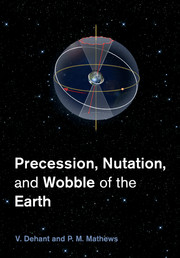Book contents
- Frontmatter
- Contents
- Preface
- List of abbreviations
- 1 Introduction – Fundamental definitions – Motivation
- 2 Concepts and elementary theory
- 3 Reference systems and frames
- 4 Observational techniques – ephemerides
- 5 Rigid Earth precession and nutation
- 6 Deformable Earth – Love numbers
- 7 Nutations of a non-rigid Earth
- 8 Anelasticity
- 9 Ocean and atmospheric corrections
- 10 Refinements of non-rigid nutation
- 11 Comparison observation-theory
- 12 Conventions
- 13 Mars nutations
- Appendix A Rotation representation
- Appendix B Clairaut theory
- Appendix C Definitions of equinoxes
- Bibliography
- Index
6 - Deformable Earth – Love numbers
Published online by Cambridge University Press: 05 May 2015
- Frontmatter
- Contents
- Preface
- List of abbreviations
- 1 Introduction – Fundamental definitions – Motivation
- 2 Concepts and elementary theory
- 3 Reference systems and frames
- 4 Observational techniques – ephemerides
- 5 Rigid Earth precession and nutation
- 6 Deformable Earth – Love numbers
- 7 Nutations of a non-rigid Earth
- 8 Anelasticity
- 9 Ocean and atmospheric corrections
- 10 Refinements of non-rigid nutation
- 11 Comparison observation-theory
- 12 Conventions
- 13 Mars nutations
- Appendix A Rotation representation
- Appendix B Clairaut theory
- Appendix C Definitions of equinoxes
- Bibliography
- Index
Summary
Hydrostatic equilibrium Earth models
The structure of the Earth is pictured as that of a molten ball which has since frozen into the present structure, with what is regarded as a solid mantle enclosing the core regions. If the Earth had been a non-rotating body, its structure would have been spherically symmetric under a balance of internal forces: the force of self-gravitation which tends to pull the matter towards the Earth's center, balanced by the elastic forces that are called into play by the gravitational compression. However, the rotation about the polar axis brings with it the associated centrifugal force. When we ignore the variations in Earth rotation, which are extremely small compared to the steady part of the rotation characterized by the mean angular velocity vector _0, the associated time independent centrifugal force acts on every element of matter and is directed outward from the axis of rotation along a line that is perpendicular to this axis and passes through the matter element. The effect of this additional force is to cause the symmetry of the Earth's shape and structure to become ellipsoidal instead of spherical, with the axis of the mean rotation as the axis of symmetry. The actual Earth structure is very nearly the same as the hydrostatic equilibrium (H.E.) structure which is what a wholly fluid body would assume under the combined action of the centrifugal force and the much larger gravitational and elastic forces. This structure is characterized by surfaces of constant density which are axially symmetric oblate ellipsoids. Other properties such as the elastic moduli and the geopotential (made up of the gravitational and centrifugal potentials) are also constant on each of these surfaces. The construction of such an ellipsoidal model is done by the application of Clairaut's theory of hydrostatic equilibrium structure (Clairaut, 1743), starting from a spherically symmetric model representing the equilibrium structure of a hypothetical non-rotating Earth. The latter is specified by giving the density and elastic moduli as functions of the radial variable r alone.
- Type
- Chapter
- Information
- Precession, Nutation and Wobble of the Earth , pp. 210 - 256Publisher: Cambridge University PressPrint publication year: 2015



